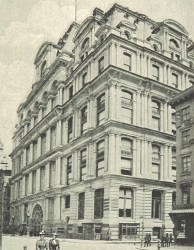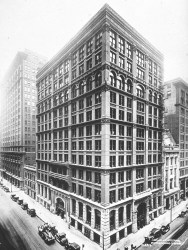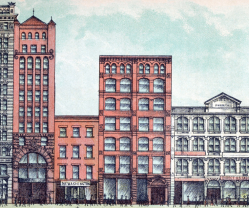It is hard to imagine that for thousands of years, the Great Pyramid of Giza was the tallest manmade structure in the world. However, like the Lincoln Cathedral and the Washington Monument, which also held that title, these don’t count as skyscrapers because they didn’t provide living or working space to people. But aside from providing living, retail, or office space, skyscrapers also share a common feature that explains why they are even possible: steel frame construction.
Have you ever wondered why pyramids appear in so many ancient civilizations? The answer is engineering. You build something. Then, you build something on top of it. Then you repeat. It just makes sense. But each upper layer adds weight to all the lower layers, so you must keep getting smaller. Building a 381-meter skyscraper like the Empire State Building using self-supporting walls would mean the ground floor walls would be massive. Steel lets you get around this.
In Antiquity
You might think of high-rise buildings as a modern thing, but that’s actually not true. People seem to have built up to the best of their abilities for a very long time. Some Roman structures were as high as ten stories. Romans built so high that Augustus even tried to limit building height to 25 meters — probably after some accidents. In the 12th century, Bologna had as many as 100 towers, one nearly 100 meters tall.
There are many other examples, including mudbrick structures rising 30 meters in Yemen and 11th-century Egyptian structures rising 14 stories. In some cases, building up was due to the cost or availability of property. In others, it was to stay inside a defensive wall. But whatever the reason, self-supporting walls can only go so high before they are impractical.
So steel and iron frames grabbed the public’s attention with things like Joseph Paxton’s Crystal Palace in 1851, and Gustav Eiffel’s Tower in 1887.
Steel Frames

Exactly where the first modern skyscraper appears is a topic of hot debate, if you are a skyscraper enthusiast, and a steel frame alone is probably not sufficient. One candidate is the 1797 Flaxmill in Shrewsbury, England. It was only partially iron-framed, but was a hint of what was to come. However, at five stories, it wasn’t what we’d consider a skyscraper. Besides, the iron frame was more to prevent fires in the mill, not to hold a tall structure.
Another early sort of skyscraper showed up in Liverpool in 1864. Oriel Chambers wasn’t particularly tall, at five stories, but it did use a steel frame and, because the walls were not bearing load, it contained many windows. Critics reacted negatively to all the glass, but the future would prove that glass “curtain walls” would be a very successful design.
Other Considerations
Just building a tall structure is only part of the problem with making a successful skyscraper. One thing you really need is an elevator. Otis created the safety elevator in 1857, although passenger elevators would wait until 1870. You also need a way to handle water and a plan for fire safety.
Even with steel frames, going taller means thicker metal columns. By the 1960s, a Bangladeshi engineer, Fazlur Rahman Khan, replaced many large interior columns with smaller steel and concrete columns, forming a tube-like structure. This requires less material and improves strength. For example, the Willis Tower (what used to be the Sears Tower) uses about 66% of the steel the Empire State Building uses but is higher by more than 60 meters.
The other issues that arise are from external forces. Wind pushing against a lot of surface area has more force than you think, so some skyscrapers have air gaps to reduce loading. Tiny vibrations at the bottom of the tower can cause large movement at the top, too, so some buildings include mass dampers to reduce swaying.
Dr. Ed Glaeser of Harvard University argues that you couldn’t have skyscrapers without cheap, high-quality metal from industrial advances tied to the steam engines and elevators. He also argues that there isn’t a single creator of the skyscraper, but rather, they are a collaboration of very smart people working to solve a problem.
So, The First?
Because “skyscraper” is not a precise term, there’s some debate over what was really the first one. The Home Insurance Building in Chicago is one vote. In 1885, it was a record-setting 42 meters tall. However, some would argue that Manhattan’s Equitable Life Building from 1870 should hold the title. It did have the first commercial passenger elevator and weighed in with nine floors. It was around 40 meters in height. Others argue for the 1889 Tower Building in Manhattan.
The Tower Building had 11 floors, and the bottom seven were iron framed. It was built from necessity. The available lot on Lower Broadway was only six and a half meters wide. Slender buildings — that is, ones that have a small base-to-length ratio — require special consideration.
Skyscrapers Today
Depending on how you define skyscrapers, there are many cities today that boast a skyline full of them. There are 14 cities in the world that have more than 100 buildings taller than 150 meters. Hong Kong leads, and New York City is in third place. The only other US city on the list is where the skyscraper largely originated: Chicago. It is, however, 11 places behind New York. However, many other cities have a respectable number of tall buildings, and there are more built every day.
The tallest in the world, at the moment, is the Burj Khalifa in Dubai, standing at 828 meters. That’s nearly twice the size of the old Sears Tower, the tallest building in the world for many years. Of course, you have to be careful when making comparisons. Some skyscrapers have a “vanity” height because they claim some piece of structure that isn’t really part of the building. For example, the Empire State Building has a 61-meter tall airship mooring that — outside of being used by King Kong — was probably only put there to get taller than the Chrysler Building. That picture of the airship Los Angeles docked there in 1930? Fake, as you can see in the Wall Street Journal video below. Guess you didn’t need PhotoShop to doctor up a picture in 1930. The Goodyear blimp Columbia did manage to lower some newspapers to the top of the building once but could not repeat the feat due to the winds always blowing around the building.
Usually, when we talk about architecture here, we talk about a CPU. But not always. Skyscrapers are a great example of how human design visions sometimes have to wait for engineering to catch up.


















The initial picture shows another interesting and related tech: self-erecting construction cranes.
Oriel Chambers was 5 stories tall!
Why isn’t he listed in the Guinness Book of World Records?
B^)
In “On High Steel, ironworker Mike Cherry points out that the Empire State building and other earlier skyscrapers had setbacks at certain heights. The base of the building covers the entire lot; if setbacks of smaller area at different heights were not required, eventually there would be so many rectangular skyscrapers in NYC that sunlight would reach the ground only at noon. The World Trade Center and similar later construction were able to avoid setbacks by simply making the base of the building smaller than the lot on which it was built.
Cherry’s most memorable (to me) statement in the book: “After thirty feet, it doesn’t much matter how far you fall.” Somehow, when looking down from a few dozen stories, it’s not a comfort… :-p